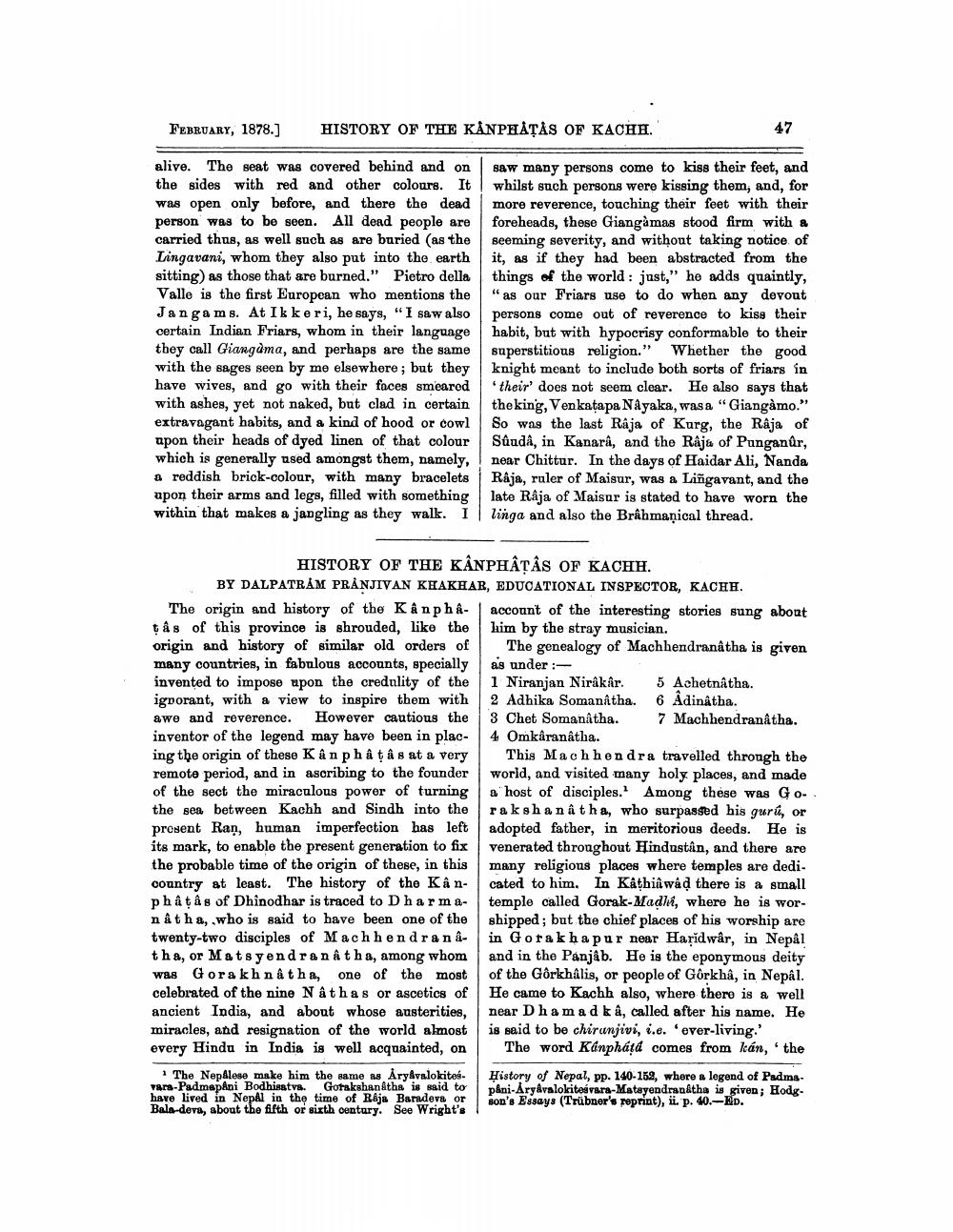________________
FEBRUARY, 1878.]
HISTORY OF THE KÅNPHÁTÅS OF KACHH.
47
alive. The seat was covered behind and on the sides with red and other colours. It was open only before, and there the dead person was to be seen. All dead people are carried thus, as well such as are buried (as the Lingavani, whom they also put into the earth sitting) as those that are burned." Pietro della Valle is the first European who mentions the Jangams. At Ikke ri, he says, “I saw also certain Indian Friars, whom in their language they call Giangama, and perhaps are the same with the sages seen by me elsewhere; but they have wives, and go with their faces smeared with ashes, yet not naked, but clad in certain extravagant habits, and a kind of hood or cowl upon their heads of dyed linen of that colour which is generally used amongst them, namely, a reddish brick-colour, with many bracelets upon their arms and legs, filled with something within that makes a jangling as they walk. I
saw many persons come to kiss their feet, and whilst such persons were kissing them, and, for more reverence, touching their feet with their foreheads, these Giangamas stood firm with a seeming severity, and without taking notice of it, as if they had been abstracted from the things of the world : jast," he adds quaintly, "as our Friars use to do when any devout persons come out of reverence to kiss their habit, but with hypocrisy conformable to their superstitious religion." Whether the good knight meant to include both sorts of friars in
their' does not seem clear. He also says that the king, Venkatapa Nayaka, was a "Giangamo." So was the last Raja of Kurg, the Raja of Sûudå, in Kanarâ, and the Raja of Punganûr, near Chittur. In the days of Haidar Ali, Nanda Råja, ruler of Maisur, was a Liñgavant, and the late Raja of Maisar is stated to have worn the linga and also the Brâhmaņical thread.
HISTORY OF THE KÂNPHÂTÂS OF KACHH. BY DALPATRÅM PRANJIVAN KHAKHAR, EDUCATIONAL INSPECTOR, KACHH. The origin and history of the Kanph- account of the interesting stories sung about tâs of this province is shrouded, like the him by the stray musician. origin and history of similar old orders of The genealogy of Machhendranatha is given many countries, in fabulous accounts, specially as under :invented to impose upon the credulity of the 1 Niranjan Nirakar. 5 Achetnatha. ignorant, with a view to inspire them with 2 Adhika Somanâtha. 6 Adinatha. awe and reverence. However cautious the 3 Chet Somanatha. 7 Machhendranatha. inventor of the legend may have been in plac- 4 Omkaranatha. ing the origin of these Kân ph â tâs at a very This Mach hendra travelled throngh the remote period, and in ascribing to the founder world, and visited many holy places, and made of the sect the miraculous power of turning a host of disciples. Among thèse was Go.. the sea between Kachh and Sindh into the raksha na tha, who surpassed his gurú, or prosent Ran, human imperfection has left adopted father, in meritorious deeds. He is its mark, to enable the present generation to fix venerated throughout Hindustan, and there are the probable time of the origin of these, in this many religious places where temples are dedicountry at least. The history of the Kâ n- cated to him. In Kathiawad there is a small ph â t à s of Dhinodhar is traced to Dharma- temple called Gorak-Madh, where he is wornátha, who is said to have been one of the shipped; but the chief places of his worship are twenty-two disciples of Machhendran a- in Gorakhapur near Haridwar, in Nepal tha, or Matsyendranatha, among whom and in the Panjab. He is the eponymous deity was Gorakhnatha, one of the most of the Görkhålis, or people of Görkhå, in Nepal. celebrated of the nine Nathas or ascetics of He came to Kachh also, where there is a well ancient India, and about whose austerities, near Dhamad kâ, called after his name. He miracles, and resignation of the world almost is said to be chiranjivi, i.e. ever-living.' every Hindu in India is well acquainted, on The word Kanpháid comes from kán, the
The NepAlese make him the same as AryAvalokites. History of Nepal, pp. 140-152, where a legend of Padmavara-PadmapAni Bodhisatva. Gotakshan&tha is said to
pani-Aryavalokitesvara-Matayendranatha is given; Hodg. have lived in Nepal in the time of Roja Baradeva orson's Essays (Trübner's reprint), ii. p. 40.-HD. Bala-deva, about the fifth or sixth century. See Wright's




